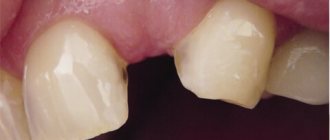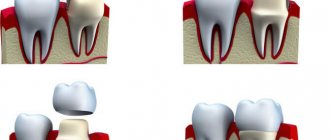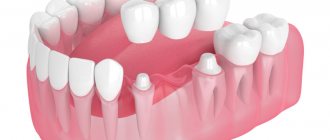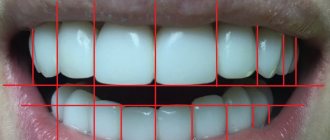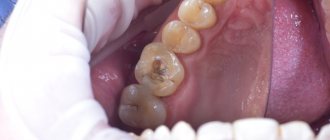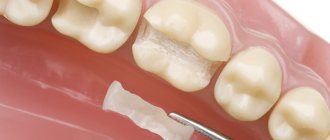The difference between filling and tooth restoration
Restoration of the anterior and chewing teeth with filling material allows you to restore the anatomical shape, integrity and functionality of the dental crown. In fact, a filling performs approximately the same functions. But there are still differences between these two recovery methods, and they are significant:
- Filling involves, first of all, restoring the functional parameters of dental tissues, and tooth restoration is aimed at restoring not only functionality, but also aesthetics - materials are selected in such a way as to most accurately imitate natural dentin and enamel, their color and degree of transparency.
- Installing a filling is a purely therapeutic procedure, while restoration procedures combine both treatment and artistic restoration.
- Fillings are installed when no more than a third of the crown of the tooth is destroyed. Restorative measures can be carried out in cases of more significant destruction of the crown, as well as in cases where the dental crown is visually intact, but it is necessary to correct its shape, color, or correct wide interdental spaces.
Number and group designation
Units of the upper and lower dentition are divided into chewing and frontal (front). In dentistry, there is no single recognized system for classifying teeth. However, it is generally accepted:
- universal (each of the 32 teeth has a serial number. Counting starts from the upper jaw, from right to left. Under No. 1 is the rightmost molar. On the lower jaw are No. 17-32, and are counted from left to right. Milk units are designated by letters of the Latin alphabet);
- square-numeric (the simplest and most common system for designating the number and group of a tooth. Numbering starts from the central incisor. Children are designated by Roman numerals);
- two-digit (similar to the previous one. It differs in the ability not to write where exactly the tooth is located, but simply to designate the quadrant with a number);
- alphanumeric (used to describe bite pathologies. In this classification, incisors are designated by the letter I, canines - C, premolars and molars - P and M, respectively);
- Haderup system (numbering starts from the middle (center) of the jaw. The upper jaw is designated “+”, the lower – “-“.
What does dental restoration mean and how is it done?
Dental restoration with filling material is a complete restoration of the integrity, functionality and aesthetic qualities of the dental crown with precise selection of color and transparency of materials to match the natural dental tissues. It is performed by a dentist using layer-by-layer application of filling materials of various shades in order to recreate the natural color of the enamel as much as possible. In this case, the doctor pays attention not only to the selection of color, but also to the precise restoration of the shape of the crown.
The final stage of restorative procedures will be grinding and polishing with special tools for dental restoration - such procedures give the tooth surface smoothness and a natural “wet shine” characteristic of healthy enamel.
Restoration of anterior teeth
DISPLAY ALL FEARS AND MYTHS ABOUT RESTORATION
NOW AS SIMPLE AS 1-2-3
Restoration is needed only for adult patients; children need a simple filling.
Very often, parents do not take their child’s baby teeth seriously – why treat them, they will fall out anyway. As a last resort, in case of pain, children are given a conventional filling, which, unfortunately, does not restore physiological interdental contact. But for a growing organism, interdental contacts play an extremely important role, because the child’s jaw and bite are just forming. Any disturbance in the physiological closure of teeth in 100% of cases leads to disturbances in the bite and formation of the skeleton. Therefore, for children, high-quality dental restoration is even more important than for adults; it is a guarantee of healthy teeth and correct bite in the future.
It makes no sense to do a composite restoration - it’s still a filling and it will quickly fall off. You need to get a crown right away.
What type of restoration you need can only be determined by an orthopedist after diagnosis. Installing a crown assumes that the tooth is severely damaged. Putting a crown on a tooth that has a minor defect is the same as treating catarrh of the stomach with surgery.
In addition, dental restoration with composites has a number of advantages:
- Requires minor preparation of dental tissue.
- It can be carried out on small areas of the tooth very gently.
- Modern polymer composites (not cements) make it possible to achieve not only a remarkable aesthetic effect, but also high strength of the restoration. The main condition is compliance with the technology, but this condition is important for any type of restoration.
- The composite material fits tightly to the edges, which virtually eliminates the occurrence of secondary caries or chipping.
- The cost of a composite restoration is much lower than installing a crown.
So we recommend installing a crown only in case of compelling medical indications.
Composite restoration and a regular filling are the same thing, only they charge more for the beautiful word “restoration.”
An ordinary filling cannot be a replacement for restoration because they solve completely different problems. If a filling simply “seals” a hole in a tooth and serves to isolate its tissues from the external environment, then during restoration the doctor restores the natural shape of the tooth and, MAINLY, its physiological contacts with other teeth in the dentition. The proper functioning of the dentofacial apparatus and the health of the whole organism depend on this.
So, any graduate of the Faculty of Dentistry can place a filling, but performing restoration requires experience and highly qualified specialists.
Dental restoration with veneers
Veneers are thin shells that are glued to the tooth and can improve the aesthetic appeal of the dentition. Restoration with veneers is, in fact, prosthetics performed by an orthopedic dentist. Various types of veneers can be used for the procedure:
- from composite materials (therapeutic or composite materials)
- ceramic (orthopedic);
Veneers made of composite materials. These are plates made of a material similar to that from which fillings are made. Only in the case of veneers does production take place entirely in the factory. Already in the patient's mouth, each veneer is individually adjusted to the tooth. This can also be done by a general practitioner, which is why they are otherwise called therapeutic veneers. In our clinic we offer the best composite veneers from the Swiss company Colten.
Ceramic veneers . The best option for aesthetic restoration in the smile area. They are made in the laboratory individually for the patient’s teeth from durable ceramics. At the same time, they have the most natural appearance. Ready-made ceramic veneers look like “natural” teeth, so it is almost impossible to recognize them visually. Their service life is long - on average it is 20 years. Of course, ceramic veneers are more expensive than composite veneers. However, it is ceramics that provide ideal dental aesthetics and long-term results.
Methods
The process of restoring the front teeth is carried out using one of the existing methods, which is selected individually by a specialist. The composite material is fixed directly into the cavity or an inlay is first made, which is then attached to an adhesive composition:
- direct reconstruction involves applying a filling compound to the prepared area in accordance with the technology and rules for using the selected material;
- indirect restoration involves the use of inlays, which are made outside the patient’s mouth in a laboratory setting. Fixation is carried out in the damaged area using special cement.
In order to determine the most suitable restoration method, the specialist assesses the extent of the damaged area, the bite and other characteristics of the patient. Without a preliminary examination and elimination of the consequences of caries or other types of lesions, no specialist will choose a method and material. Errors made at the preparatory stage negatively affect the service life of fillings and inserts, so there is no need to speed up the restoration process. In addition, they are incredibly durable, subject to a tiny percentage of abrasion, and have low polymerization shrinkage.
Medical Internet conferences
Relevance. Today, dental therapists in clinical practice often have to carry out aesthetic restoration of anterior teeth using composite materials. Requirements for the treatment of anterior teeth are increasing as materials and instruments improve. Methods for recreating dental aesthetics, used in a dental laboratory, are not always suitable for use in a therapeutic dentistry clinic. This is due to the peculiarities of performing restoration in the oral cavity, the properties of composite materials, as well as the limited working time of the doctor [3]. Improvements in materials and restoration techniques have made it possible to satisfy the high aesthetic requirements of patients. Thus, the vast majority of people expect the dentist to create so-called invisible restorations [5]. Patients are interested in preserving more tooth structure and want to be involved in choosing the color and shape of future work. They also set the dentist the task of predicting the final result even before the start of treatment [2, 4]. Therefore, it is important for the doctor to keep up with the development of new technologies and improve his manual skills, improving the quality of restorations. Dentists are often faced with a choice between direct and indirect methods for restoring anterior teeth [1].
Purpose: to analyze the use of a composite restoration system for anterior teeth.
Objectives: 1. Determine the advantages of the system for the doctor. 2. Determine the benefits to the patient.
3. Identify weaknesses.
4. Compare composite and ceramic veneers using a survey method.
Materials and methods. During the work, an analysis of medical books, manuals, and articles was carried out. Questioning 150 people from different cities.
Results and discussion. A composite veneer is a standard overlay that imitates tooth enamel. Such overlays are made from a polymerized highly filled nanohybrid composite using an industrial method. Composite veneers (or enamel onlays, or plates) in the cervical area have a thickness of 0.3 mm, and in the area of the cutting edge - up to 0.7 mm. Currently, this system includes a choice of three sizes of onlays (small, medium and large) for the anterior group of teeth in both jaws, as well as two types of onlays that differ in the degree of opacity - white and universal.
The composite onlay system is available as a basic system-kit, which includes 36 veneers, or a remium system-kit with 84 veneers. These kits also include tools and a set of additional materials.
Templates. They are bluish transparent forms that provide an exact match to the contour of the patient’s tooth and, thus, allow you to easily select the size of the composite for the future restoration that is necessary for the job (3 sizes for each jaw).
Holder. The holder is a specially designed tweezer. Serves as a tool for applying bond and restoration material to the enamel plate, as well as adjusting its shape. The holder has black protective caps (replaceable attachments) that protect the veneer from damage while working with the restoration.
Tool for installing veneer. A tool that is used to properly place and align veneers to prevent them from slipping during manipulation.
Modeling tool. Its peculiarity is that the tool has a very sharp and thin spatula end. This allows you to carefully remove excess composite. This design ensures free rotation of the tool during modeling.
Nanofilled microhybrid composite material from which the plates are made.
One-component adhesive system. V generation adhesive, which is used in the total etching technique. It is water soluble and therefore less volatile. This property allows you to increase the working time when applying the material to the composite. The high adhesion force of the material to the tooth tissue ensures a long-term marginal fit of the restoration.
Polishing discs and strips of different abrasiveness, polishing heads (cups and cones), natural bristle brushes. When performing restoration work, all stages of the adhesive technique are maintained, including the following manipulations: isolation of the working field using a rubber dam, preparation of the tooth surface, treatment with orthophosphoric acid, application of adhesive and material, polymerization, as well as grinding and polishing of the completed restoration [7].
100 people from different cities took part in the survey. The question was: “If you had to face such a problem as “aesthetic restoration of the frontal group of teeth,” what would you choose: installation of composite veneers or installation of ceramic veneers?” The result of the survey is as follows: 70% of respondents made their choice in favor of ceramic veneers, 11% gave their preference to composite veneers, the remaining 19% of respondents found it difficult to answer. Most potential patients said that the main criterion for their choice was the ratio of cost and quality of restoration.
As for the comparison of such methods of recreating the aesthetics of a tooth as installing a composite and restoring a tooth defect (for example, a chip) by replenishing the loss of tissue using a composite material in the usual way, the second method is more accessible to the patient. This was shown by the results of a survey among patients who had previously encountered such a problem as a chipped tooth in the frontal area. The survey was conducted on the Internet. 50 patients from different cities took part in the survey. They were asked the question: “Which method did you prefer for restoring a chipped defect: installing a composite veneer or recreating the tooth anatomy in the usual way?” The result of the survey is as follows: 2% of respondents chose the installation of a componer, 86% gave preference to the conventional method of tooth restoration, 12% found it difficult to answer. Many justified their choice by the fact that they believe that even minimal grinding of healthy enamel can lead to a poor prognosis.
Conclusions:
1) Advantages for the doctor: - Good adhesion between the composite and the enamel onlay;
- Adheres well to the gum;
— There is no shrinkage of the material and no tearing off;
— The surface is quite durable;
— You can conveniently and clearly select the color, taking into account the patient’s wishes;
— Minimal abrasion of the veneer if the recommendations are followed;
2) Benefits for the patient: - Minimal abrasion of the veneer if the recommendations are followed; — If you follow the recommendations, the risk of staining the enamel is minimized; — Reduced risk of caries recurrence; — Aesthetic restoration.
3) Disadvantages of the system:
— Limited choice of colors and shapes of veneers;
— Erasure, loss of shine and pigmentation of borders over time;
— Available contraindications for use: violation of occlusion, abrasion of teeth during bruxism.
4) If we compare composite veneers with ceramic ones, the former are inferior to the latter in such qualities as strength, durability, choice of color and shape. The advantages of installing composite veneers for patients compared to ceramic ones are their relative cheapness (on average 2-4 times cheaper) and fewer visits to the dentist.
Thus, the technology described above is an effective method of direct restoration, complementing existing techniques used for aesthetic restoration of teeth. However, this technique currently has a number of disadvantages.
Price
The cost of aesthetic restoration is always individual and depends on several factors, such as the volume of the aesthetic defect, the method and type of restoration, technologies and materials used in preparation for restoration and directly during its implementation, and the qualifications of the attending physician. In addition, the cost is affected by diagnostic measures before restoration and consultations with specialists, if necessary.
Aesthetic dental restoration is a delicate, jewelry work, the quality of which depends on the qualifications and experience of the dentist. But a lot also depends on the patient: proper oral hygiene after restoration, giving up bad habits such as the habit of gnawing on objects (nuts, pens, etc.), mandatory visits to the clinic every six months for a preventive examination, and professional hygiene procedures. and polishing the restoration. If these simple conditions are met, veneers and lumineers, inlays and onlays will serve you for as long as possible, and your beautiful smile will delight you and those around you for many years.
According to https://text.ru/antiplagiat/unauthorized, the uniqueness of the text as of 08/31/2017. - 99%.
Key words, tags: hygienic care, veneers, caries, periodontitis.
*Physiognomic height of the face (tr-gn) is determined between the point (tr), located on the sagittal plane on the border between the forehead and the scalp, and the point gn. **Images: Database of clinical photo protocols of the Dr. Dental Clinic. Edranov. 1 E. A. Karmalkova, t. V Tretyakova, v. N. Belevich. "The Face of a Man" Original scientific publications. Treatment and prophylactic issues / Belarusian State Medical University, 2012. pp. 33-38. 2 Doctor of Medical Sciences, Prof. I.K.Lutskaya, N.V.Novak, Yu.P.Chernyavsky. Veneer coatings (instructions for use). Belarusian Medical Academy of Postgraduate Education. 2002 C.3.
What is aesthetic dentistry?
With the help of aesthetic dentistry, such common problems as yellow teeth, their irregular shape and location, “gummy smile”, gaps between the front teeth, malocclusion, etc. are solved. But an ideal smile cannot be achieved only with the help of aesthetic dentistry technologies, which cannot be used if the teeth are not cured of caries or the patient has problems with the functioning of the lower temporomandibular joint. Only after complete sanitation of the oral cavity has been carried out and all functional problems have been eliminated, the aesthetic dentist begins to create a perfect smile.
